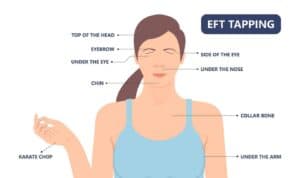Therapy
Emotional Freedom Techniques (EFT): Tapping for Healing and Balance
THC Editorial Team August 13, 2021

Contents
- Overview
- What Is EFT?
- What Is the History of EFT?
- How Does EFT Work?
- What Conditions Are Commonly Treated by EFT?
- The Potential Benefits of EFT
- The Effectiveness of EFT
What Is EFT?
Emotional freedom techniques (EFT), sometimes referred to as emotional freedom technique, EFT tapping, or tapping, is an alternative approach to therapy premised on the idea that physical and emotional pain is created by disruptions or blockages in the body’s energy system.1 Practitioners believe that disturbances in energy flow can be released by tapping fingers on different parts of the body, called meridian points, to help alleviate symptoms and rebalance energy. EFT consists of a “comprehensive algorithm” that addresses a multitude of illnesses and conditions.1
Considered a form of energy therapy, EFT treatment draws from the following practices:1,2
- Thought Field Therapy (TFT)
- acupoint stimulation and meridian points
- neuro-linguistic programming (NLP)
- exposure therapy
- cognitive and cognitive behavioral therapy (CBT)
- acceptance-based therapies
- eye movement desensitization and reprocessing (EMDR)
- somatic stimulation
EFT is the most widely practiced form of energy psychology.2
What Is the History of EFT?
Gary Craig, an engineer who graduated from Stanford University, established EFT in the 1990s after studying with psychologist Roger Callahan, who founded Thought Field Therapy (TFT) a decade earlier. Drawing on the foundations in TFT, another energy psychology and tapping-based intervention, Craig developed EFT by proposing what he considered an improved and simplified technique that involved fewer tapping points.3 As a trained expert in neuro-linguistic programming, Craig also incorporated those techniques into EFT practice.
Craig manualized EFT and freely published The EFT Manual on his website, emofree.com, in the mid-1990s. Since then, it has been used more broadly both in therapeutic approaches and in other applications and remains largely unchanged from the original version developed by Craig.3
How Does Emotional Freedom Techniques (EFT) Work?
Like acupuncture and acupressure, EFT was founded on the idea that imbalances or blockages can cause adverse physical or psychological health effects in the body’s energy flow and that tapping on the body’s meridian points helps alleviate symptoms. However, unlike acupuncture, EFT uses finger tapping instead of needles to release these energy blockages.
Some research has shown that directing pressure to acupuncture points (i.e., acupressure) or tapping meridian points can produce similar results when compared to using needles in acupuncture.1,2 Specifically, EFT tapping “seems to result in limbic system downregulation that is similar to that following the needling of specific acupuncture points.”2
According to EFT practitioners, tapping fingers on meridian points while simultaneously thinking about a specific problem that needs to be addressed helps restore energy balance and resolve emotional or physical issues.1
EFT Tapping Points (Meridian/Acupressure Points)
The tapping points are located on the head, hands, and torso, and include:4,5
- side of hand (karate chop point)
- top of head (crown of head)
- eyebrow point
- side of eye
- under eye
- under nose
- chin point
- collarbone
- underarm
Source: rumruay on Shutterstock
Some additional points used by some tapping practitioners include:5
- gamut point
- liver point
- finger points
- wrists
- thymus
Two primary applications of EFT include:3
Practitioner-assisted EFT
This type of EFT is a one-on-one tapping session conducted by an expert EFT practitioner.
Self-administered EFT
This type of EFT is a form of self-help and self-care, assisting individuals to “rapidly self-soothe and come into calm.”3
According to Dawson Church, a leading EFT researcher and practitioner, EFT “appears to be safe when administered by a therapist or life coach, or self-administered.”6
At the beginning of a typical session, whether working with an EFT practitioner or alone, an individual identifies, acknowledges, and states what issue they want to address. This typically involves recalling an emotionally distressing or traumatic event. The individual also establishes the initial intensity, or distress level, of their feelings associated with the presenting issue on a Likert-type scale from 0 to 10, with 10 representing maximum distress. This type of scale is called a Subjective Units of Distress Scale (SUDS) and is used to measure a client’s level of discomfort.7 Participants next verbalize a “setup” statement that addresses the subject of distress.
Following this, the person will voice self-affirmations, typically involving acceptance and self-acceptance, to change the narrative or cognition surrounding the distressing topic.
For example, someone who struggles with external judgment might state that they fear how they appear to others, but still accept and love themselves for who they are in spite of the traumatic event or distressing thinking involved. The person will repeat the statement three times while stimulating (in the case of self-administered EFT) a specific meridian point by tapping on it five to 10 times with their fingertips.4,5
This process can be repeated several times until the person can rate the physical and emotional distress around the initial issue statement as a number close to zero. The entire process can then be repeated with other statements related to the presenting issue.
What Conditions Are Commonly Treated by EFT?
EFT can be applied to a range of conditions, and the “treatment protocol includes a comprehensive algorithm used for all types of problems and symptoms.”1 For example, EFT has been studied in the following:8
- anxiety
- depression
- posttraumatic stress disorder (PTSD)
- phobias
- pain and physical conditions
- athletic performance
- weight loss
- cravings
The Potential Benefits of EFT
The potential benefits of EFT as found by researchers include the following:
- reduction in stress2
- reduction in anxiety symptoms2,9
- reduction in pain1
- alleviation of PTSD symptoms2,9
- increased sense of calm1
- reduced frequency and symptoms of tension headaches2
- reduced symptoms of fibromyalgia1,2
- symptom improvement in traumatic brain injury2
- improvements in people with seizure disorders2
- improvements in people with insomnia2
- improvements in chemotherapy side effects2
- reduction in psoriasis2
- emotional improvements9
- reduced resting heart rate9
- reduced blood pressure9
- reduced cortisol levels9
- improved immune function9
The Effectiveness of EFT
As with some other energy-based therapeutic approaches, some scholars and clinicians have been skeptical of EFT and have viewed it as “fringe therapy.”6 However, there are currently more than 100 articles published in peer-reviewed journals on the effectiveness of EFT across a variety of conditions.7 Most of these have been conducted in recent years. When “measured against the standards of the American Psychological Association’s Division 12 Task Force on Empirically Validated Treatments, EFT is found to be an ‘evidence-based’ practice for anxiety, depression, phobias, and posttraumatic stress disorder (PTSD).”7
It is important to note that many of these studies involve what is called “clinical EFT,” which, according to Church, “… is the ‘evidence-based’ method that has been validated in research studies that meet APA standards”; typically refers to The EFT Manual; and includes “exposure, cognitive shift, and acupressure.”6
For example, a recent study found that EFT can effectively reduce symptoms of anxiety, burnout, and stress among nurses. The authors recruited 35 nurses who received EFT treatment and compared them with a no-treatment group of 37 nurses. All of the nurses were involved in treating individuals with COVID-19. They found that the nurses who participated in a single online EFT group session experienced significant reductions in anxiety, stress, and burnout.10
In another study, researchers compared groups who participated in either 1-hour EFT sessions, 1-hour psychotherapy sessions, or no treatment. They found that the participants assigned to the EFT group experienced statistically significant improvements in anxiety, depression, and severity of symptoms and a more substantial decrease in cortisol levels than the psychotherapy group and the no-treatment group.9
A meta-analytic review completed in 2016 also found potential benefits of EFT for people with anxiety disorders. Researchers reviewed data from 658 people in 14 studies and found that people who received EFT demonstrated a significant reduction in anxiety scores.4
Studies have also found that EFT might offer benefits to people who suffer from chronic pain. For example, one study found that people who suffer from tension headaches may experience a reduction in the frequency and intensity of their headaches with EFT.2 Another study found that people who experienced frozen shoulder, range of motion limitations, and related psychological symptoms also derived relief after EFT.11
A 2013 study using a randomized control design found significant improvements in symptoms experienced by veterans with PTSD following EFT. The researchers recruited 59 participants. Of those individuals, 30 participants were assigned to an EFT group, and 29 participants were assigned to a standard-of-care/wait-list group. The EFT group participants received six 1-hour EFT sessions along with the standard of care. Results of the study indicated that the EFT group had significantly reduced psychological distress and PTSD symptoms. Furthermore, 90% of the EFT group no longer met the clinical markers for a PTSD diagnosis, compared with 4% of the standard-of-care/wait-list group.12
Finally, a recent study using a randomized control design looked at 88 postmenopausal women with moderate depression. Forty-four of those women received EFT treatment, while the other 44 received a sham treatment on acupressure points. The researchers found that women who completed the 8-week EFT intervention experienced significant reductions in their mean depression scores, from 20.93 to 10.96, compared to a drop from 19.18 to 17.01 in the control group. The frequency of moderate depression also dropped from 56.8% to 9.35% in the EFT group compared to 50% to 29.5% in the control group.13









